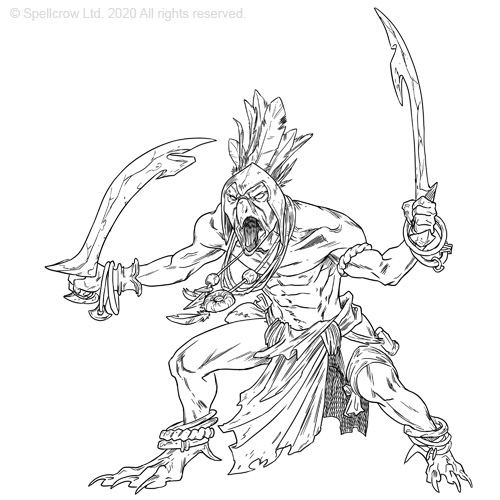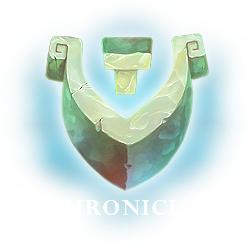
Since ancient times, the central part of distant Argatoria covered with green hills and rocky cliffs are inhabited by tall slender hunters whose muscular silhouettes and bird faces distinguish them from other wild people inhabiting these lands.
With a bone weapon, full of engraved decorations, they roam their vast land on the backs of the mighty beasts that they called Yuara, in honour of the hero who managed to subdue them. It is a tradition to train these brutal hairless animals with large fangs so that they are ready for the Great Hunts and long trips outside the settlements. Thanks to them, the villages gain food and pelts, and during the hunts, young warriors prove whether they are worthy of being named Vorak’hous. The Great Hunts are prepared by the village elders in the fumes of olibanum and monotonous music and songs during which the weapons of warriors are sacrificed. Younkers who don’t survive the hunt return, according to beliefs, to the bodies of the sky creatures, where their souls learn humility and await their comeback to their native settlement. Those whom Mother Argatea was taking care of return with trophies, placing them at the entrances of their habitations which can only marry those who already carry the name Vorak’hous.
Tribes are constantly wandering through their land, often fighting for dominance and the strongest name which will gain the right to the best and most dangerous hunting grounds. Tribal squabbles and frays are usually brutal and uncompromising, but they are a ritual part in which the most ruthless aggressors are women, fighting for the greatest treasure of each settlement – eggs with the young. Sometimes whole groups of men watch their fights, and the naked bodies of fighting women light up blood in their veins. The battle rituals of Vorak’hous women are so cultivated that a man who wants to separate them may lose his life as well. From time immemorial, the struggles for unborn babies that women call Horea de Are’sso cause that the strongest mother will bring up the proudest warriors, for whom she fought a bloody battle before they were even born.
Vorak’hous relations with foreign races were formerly sporadic, because the tribes were not much interested in happenings outside their land, remaining unknown to the Ancient Lands and the rest of the world. The situation changed only when the army of Humans passed through the areas of their hunts, decimated by the battles with the hordes of Sheol-morg.
Weakened troops under the command of Captain Radas of Boria went astray, moving away from the rest of the Humans army. The troops were looking for food and a place to gather forces, and as soon as they saw the village, they went in its direction, regardless of the danger. Hunger was stronger than fear…
The aliens who entered the village were a complete surprise to the Vorak’hous who lived there, for in their attack there were no ritual cries, no sacrificed weapons or a Yuara’s roar, which, as the tradition required, was essential to start the ritual fights. In a silent slaughter, starving troops have killed many villagers, whose food and jewellery have become the loot of aggressors. However, it was not the battle Radas had expected, because many of his men had fallen from the bone weapon, not hunger, especially in the fight for one of the buildings, which the villagers defended the most.
When the rest of his troops fed off fruit and meat, Radas and his friend, the magician named Saraxos, assessed the value of the strange find they had discovered in the mysterious building. At dawn, when the troops set out on their way, several caravans were filled with what Saraxos considered important and managed to persuade his friend to take the find with him. He never got to know the contents of these gray troves ornamented with various signs, because just after reaching the borders of Morten, he died of a weird strain of the flu… Captain Radas got rid of the caravans as far back as Umbra Turris, recognising that the weird find may bring him the interest of prying priests in Boria, who saw evil in everything, so certainly, they were ready to see it in these strange stones too.
Districts of the Grim City are poor and often can be mistaken for landfills, among which wander the poor living. Many of them, dazed by the stench of decay, wander among the hills of garbage, seeing no difference between sleeping and being awake. In such a terrifying place, among the rotten pieces of lettuce and carrot, from gray, ornamented Vorak’hous eggs the life was born.
Those who were close to Captain Radas said that they knew how this strange race came to the Ancient Lands and that it owed its life to a great accident…
Today Voraks, as they are commonly called, live in many parts of the Ancient Lands, mainly in cities, dealing with business, crime, or other activities in which their organisation works best. Umbra Turris is the place where you can meet them the most, here – near the smelly place, where they grew up – they created their homes and huts. You cannot only buy the rarest goods but also get what is generally unachievable. The merchant districts of other cities and slums are also full of those shouting and eternally looking around for something individuals whose behaviour and proclivity to the tribal struggles have not disappeared. Fraud, receiving and smuggling is a profession that they are doing now, being a completely distinct group from their brothers and sisters in Argatoria.
